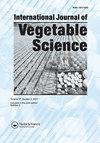A review of the effects of onion varieties with different photoperiod requirements and their origin on selecting the suitable sowing date
IF 1.1
Q2 Agricultural and Biological Sciences
引用次数: 0
Abstract
ABSTRACT Onion (Allium cepa L) varieties grow at different latitudes. Onions need cool temperatures in the early stages of growth, and high temperatures and long days during bulbing. Sowing of seed in autumn, winter, and early spring results in more leaf growth and subsequently higher bulb yield than sowing in late-spring and summer. Onion varieties show different reactions to temperature and day length. Short-day varieties need shorter day lengths and low temperatures for bulb induction compared to long-day varieties. As the required minimum day length of an onion variety is met with increasing temperatures, bulbs will be initiated. Short-day varieties reached the bulbing phase at day lengths of 11–12 h. Cultivation of short-day varieties originating from low and equatorial latitudes in areas with higher latitudes resulted in early maturity. All onion varieties, regardless of photoperiod requirements, require low temperatures in the early growing season and seedling stage. Cultivars with similar photoperiod requirements in terms of morphological and genetic traits are located in different groups. Carbohydrates are transferred from leaves to bulbs over long days and during the bulbing stage. There is a close relationship between sugar and flowering genes like AcFT2. Region, variety, and genetics of varieties influence onion bulbing.不同光周期需求的洋葱品种及其来源对适宜播期选择的影响
洋葱(Allium cepa L)品种生长在不同的纬度。洋葱在生长初期需要凉爽的温度,而在成球期间需要高温和长时间的日照。在秋季、冬季和早春播种比在晚春和夏季播种能获得更多的叶片生长和更高的鳞茎产量。洋葱品种对温度和日照长度表现出不同的反应。与长日品种相比,短日品种需要较短的日照长度和较低的温度进行球茎诱导。随着温度的升高,洋葱品种所需的最小日照长度将得到满足,鳞茎将开始生长。日照短的品种在日照长度为11-12 h时达到鳞茎期。在高纬度地区种植来自低纬度和赤道纬度的短日照品种导致早熟。所有洋葱品种,无论光周期要求如何,在生长季早期和苗期都需要低温。在形态和遗传性状上具有相似光周期需求的品种分布在不同的类群中。碳水化合物在长时间和成球阶段从叶子转移到球茎。糖和开花基因如AcFT2之间有密切的关系。地域、品种和品种遗传对洋葱鳞茎形成有影响。
本文章由计算机程序翻译,如有差异,请以英文原文为准。
求助全文
约1分钟内获得全文
求助全文
来源期刊

International Journal of Vegetable Science
Agricultural and Biological Sciences-Plant Science
CiteScore
3.10
自引率
0.00%
发文量
30
期刊介绍:
The International Journal of Vegetable Science features innovative articles on all aspects of vegetable production, including growth regulation, pest management, sustainable production, harvesting, handling, storage, shipping, and final consumption. Researchers, practitioners, and academics present current findings on new crops and protected culture as well as traditional crops, examine marketing trends in the commercial vegetable industry, and address vital issues of concern to breeders, production managers, and processors working in all continents where vegetables are grown.
 求助内容:
求助内容: 应助结果提醒方式:
应助结果提醒方式:


